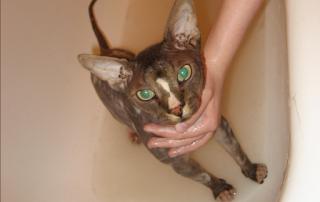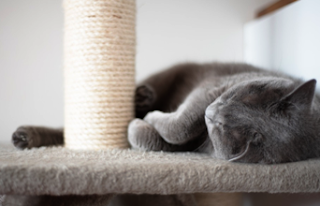Dental Care for Your Cat’s Gums and Teeth
The signs of healthy cat teeth are easy to spot. Does kitty have white teeth? Does she have any damaged or broken teeth? Do the gums look healthy? And now, the big question: How is your cat's breath? If she smells like she needs mouthwash, we have a problem!
Anatomy of the Mouth Cat Dental Anatomy
Take a close look at your cat’s mouth: You’re looking at one of nature’s most fearsome killing machines. Domestic cat teeth aren’t that different from that of a big wildcat. Look into a lion’s mouth and you’ll see remarkably similar teeth. You might not see them for long, but you’ll notice the resemblance before you’re swallowed.
An adult cat has thirty teeth, and they’re all specialized. See those long canines that frame the front of the mouth? They’re for holding prey and killing it. They’re also designed for tearing flesh. The small incisors between the long canines are for ripping flesh from the food. Further back in the mouth you’ll find premolars and molars. Cats don’t chew food as we humans do. Their molars cut food down into chunks small enough to swallow. The teeth are embedded in jaws attached to powerful muscles.
Cat Health Problems and Teeth
Why bother worrying about your cat’s teeth? Because good dental care can add years to the life of your cat. Unfortunately, cats with irreparable dental problems may sometimes have to be put to sleep.
That’s an extreme example, of course. Most cat health problems that arise from improper dental hygiene are less obvious. Bacteria from the mouth can travel through the blood stream to almost all parts of the feline body, causing heart, kidney, and liver problems. Dental health problems in cats could be compared to high blood pressure in humans: It's a silent disease that may only become apparent after some degree of damage has been done.
Bad Breath and Health
Snuggle up to your cat. Bring her face up to yours. Bring her mouth close to your nose and take a sniff. Do you smell pleasant, sweet breath, or did you just pass out from the stench? If so, you’ve just become a victim of Cat Bad Breath. Now, before you go running to the pet store for the kitty equivalent of mouthwash, you should know that bad breath can indicate some pretty serious health concerns.
Note that the odor might be the tuna you fed Fluffy immediately before you checked her breath. (In other words, don’t check your cat's breath immediately after she's eaten canned food.)
A bad odor could come from anything from minor gingivitis to advanced gum disease. Infections in and around the teeth and gums, often from tartar accumulation, are probably a leading cause of pet bad breath. Hopefully, all that your cat’s bad breath indicates is a need for some routine dental care and then a regular program of home maintenance.
Bad breath can indicate other serious health concerns. Burped up gas can point to a number of stomach and metabolic problems. One of the more serious possibilities is kidney failure. While most of us think of this in terms of the other end of the cat, urinary health, including kidney disease, can be indicated by unpleasant breath.
Look for these additional indicators:
- bad breath;
- excessive urination or frequent attempts to urinate;
- straining in the litter box;
- increased drinking;
- weight loss;
- urinating outside of the litter box;
- vomiting;
- a sudden lack of interest in grooming;
- lethargy.
The toxins normally eliminated by the kidneys build up in the blood stream and are detectable in the breath. Many veterinary experts believe that bacteria from the mouth gain access to the blood stream through diseased gums, resulting in bacteria being deposited in vital organs such as the heart and kidneys.
For a cat, bad breath is reason enough for a trip to the vet’s to rule out any serious conditions.







